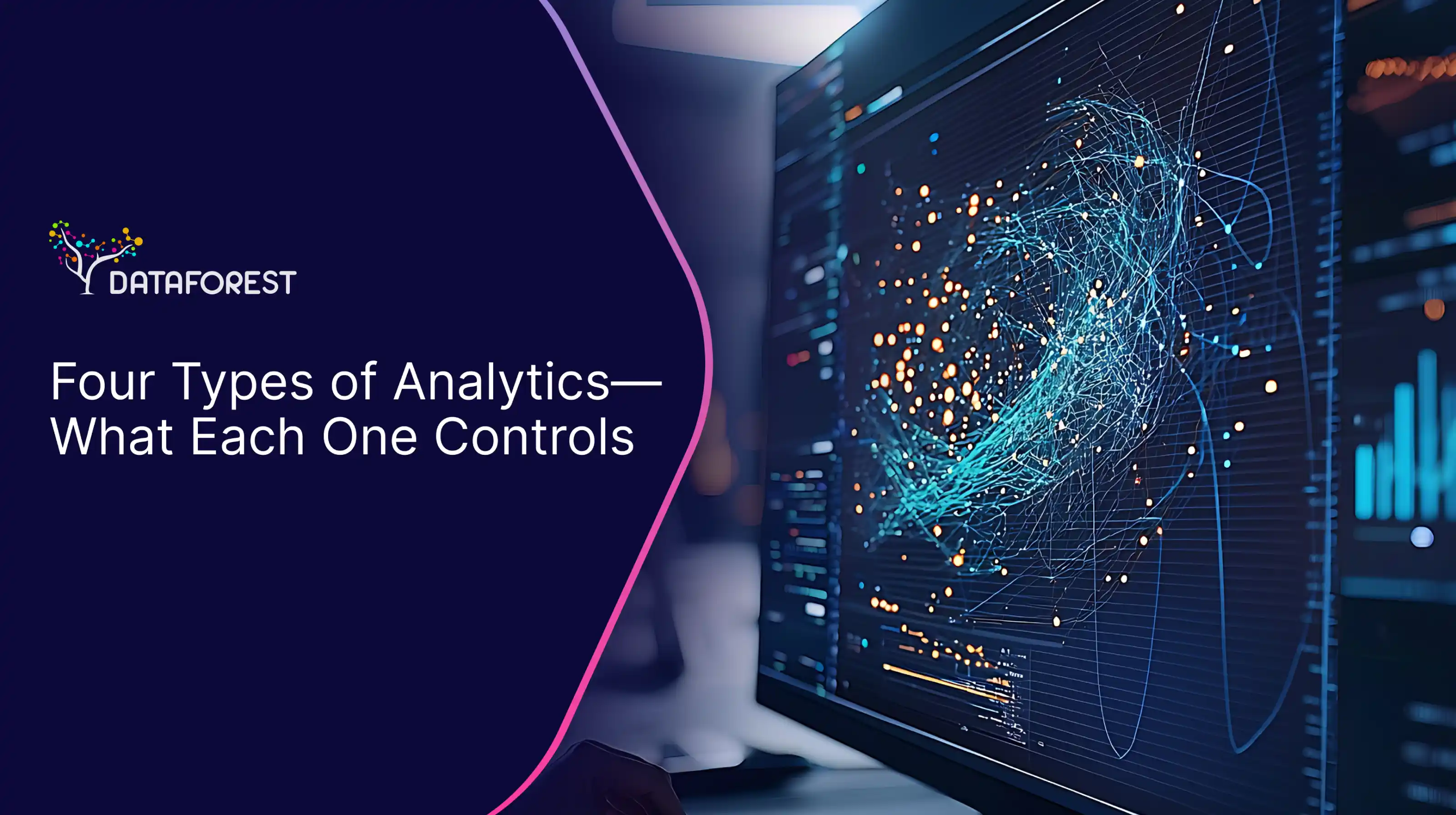5Have you heard the story about Bob, the retailer with customer data but has yet to use it? And what about the story of a business owner who regularly sent out email blasts but never tracked their impact? Well, at least an anecdote about how an online bookstore didn't adjust prices based on demand and competition. In all cases, Business Intelligence tools came to the rescue, and it turned out that business people looked but did not see the benefits. The very existence of such folklore means the importance of Business Intelligence Tools. DATAFOREST offers its rating forecast version of BI tools for 2025.

2025 Business Intelligence and Analytics Data Quadrant
BI Tools Are the Chefs of Business Strategy
For modern commerce, Business Intelligence (BI) Tools are a master chef of a five-star restaurant. They take raw ingredients (data) and whip up a gourmet meal (insights) that tantalizes the taste buds (strategic decisions). They predict trends, navigate market shifts, and examine customer preferences closely. BI tools are the cornerstone for staying agile, competitive, and data-savvy in a landscape where the currency of success is measured in bytes. DATAFOREST will do the same, you just need to arrange a call.
Business Intelligence Tools Reign over Insights
The standout features of the best BI tool of 2025, in our opinion, are:
- Seamless integration with Microsoft products.
- Real-time data processing.
- Data security.
- Customizable dashboards.
- DAX formula language.
With these features, BI tools are a business's master key, unlocking insights that drive strategic moves and competitive edge.
Selecting the Supreme BI Tool of 2025
The selection of the best business intelligence tools typically revolves around ten critical criteria:
- How well the tool integrates, processes, and manages large datasets from various sources.
- The depth and breadth of analysis the tool offers, including predictive analytics, data mining, and machine learning capabilities.
- Ease of use for non-technical users, intuitive design, and minimal training requirements.
- The ability to tailor the tool to specific business needs and scale as the organization grows.
- The quality and interactivity of data visualization.
- Features that allow for sharing and co-working on data reports.
- Support for mobile devices, enabling data access and analysis on the go.
- Including both initial setup and ongoing operational expenses.
- Availability of customer support, documentation, user communities, and resources for troubleshooting.
- Ensuring data is protected and the tool complies with relevant industry regulations.
These criteria help teams discern which BI tools align best with their operational needs, strategic goals, and data-driven decision-making processes. Below, we present the main participants of our hit parade.
Microsoft Power BI's in Business Strategy
Microsoft Power BI offers deep integration with many Microsoft products, which is like having a fast track to data management and analysis for any business already using Microsoft services. The integration is so seamless that Power BI is a natural extension of these products. Its robustness is not just in the integration but also in the comprehensive feature set. It includes but is not limited to the following:
- Power BI turns data into aesthetically pleasing and easy-to-understand visual reports. It's an artist who can paint a picture worth a thousand spreadsheet rows.
- With machine learning capabilities, Power BI uncovers trends and patterns that might take time to notice.
- It offers a collaborative environment akin to a digital roundtable, where teams make data-driven decisions.
- Users can customize dashboards to highlight the most relevant data points for their roles, much like a pilot adjusting the cockpit controls for a smooth flight.
- Power BI handles real-time data streams, providing up-to-the-minute insights as if you're watching the business world in high definition.
- It ensures that data is managed securely and complies with industry standards, acting as a digital vault for your valuable insights.
With these capabilities, Power BI not only provides a robust platform for data analysis but also enhances the strategic decision-making process. If you need an individual approach to a solution, book a call.
Visual Intelligence — Tableau
Tableau excels with its remarkable data visualization capabilities, transforming raw data into interactive reports. Here's how it stands out:
- Tableau is renowned for turning complex datasets into intuitive visual stories, making it easier for users to understand and act upon data.
- It can connect effortlessly with many data sources, both on-premises and in the cloud, ensuring a unified view of disparate data.
- With a focus on user experience, Tableau's interface is designed for simplicity and accessibility, encouraging broader adoption across business teams.
- It enables users to share insights and collaborate on data-driven decisions through its robust platform.
- Tableau offers a high degree of customization, allowing businesses to tailor the platform to their specific analytical needs.
- Its mobile-ready approach ensures that decision-makers can access insights no matter where they are.
Google Looker Studio
It’s previously known as Google Data Studio, a robust BI and analytics tool that stands out for its seamless integration with various data sources, mainly Google's services like Google Ads, Analytics, and Sheets.
- It transforms raw data into informative, easy-to-understand reports and dashboards.
- Offers connectors to various databases, storage solutions, and more, ensuring a cohesive data ecosystem.
- Designed with the user in mind, it facilitates quick and efficient report generation.
- Like Google Docs, it allows for real-time sharing of reports and dashboards.
- Users tailor dashboards to their specific needs, crafting a personalized news feed.
Google Looker Studio is considered a niche business intelligence tool because it's specifically designed to integrate seamlessly with other Google services and cater to users within the Google ecosystem. It provides deep insights primarily through its connectivity with Google Ads, Analytics, Cloud Storage, and BigQuery, making it particularly valuable for businesses that rely heavily on Google's suite of tools for their operations.
Domo — Data at the Helm
Domo is a cloud-based business intelligence platform that stands out for its end-to-end data integration and real-time operational visualization.
- Domo brings together data from disparate sources for a holistic view.
- It transforms data into dynamic and engaging visualizations.
- Domo grows with your business, handling increased data complexity with ease.
- Offers a comprehensive mobile experience for insights on the go.
- Facilitates teamwork with shared insights and collaborative dashboards.
Amazon QuickSight is the Cloud Conductor
Amazon QuickSight is also tailored as a niche business intelligence tool within the AWS ecosystem, offering a fast, cloud-powered BI service designed to be scalable and cost-effective.
- It connects effortlessly with AWS data sources like S3, Redshift, and RDS, crafting a BI solution that's a natural extension for AWS-centric businesses.
- There's no need for server setup or management, streamlining business operations focused on agility and efficiency.
- A unique pricing model that caters to the cost-conscious user, paying only for the dashboard sessions used.
- It offers machine learning-based insights, a boon for users looking for advanced analytics within the AWS framework.

Plotly Has Advanced Graphical Capabilities
Plotly is a unique BI tool that leans heavily into creating sophisticated visualizations. It's crafted for those who need to embed detailed graphs and charts into web applications.
- Plotly’s core strength lies in producing detailed, publication-quality graphs and charts.
- It integrates well with several programming languages, making it a favorite for developers and data scientists.
- Allows users to delve into the details of their data through interactive features.
- Its API supports a range of programming environments, catering to a technical audience.
Google Marketing Platform
It is a unified advertising and analytics platform for more innovative marketing and better results. It's specifically designed for marketing professionals, offering such tools:
- ad buying
- ad management
- analytics through integrated solutions like Google Analytics.
Its integration with Google's advertising ecosystem provides deep insights into campaign performance and user behavior.
Qlik is Apart from Other
Unlike traditional BI tools that rely on pre-defined queries and static dashboards, Qlik's in-memory processing allows users to conduct ad-hoc analysis and follow their train of thought in real time, uncovering hidden trends. Its user-centric design emphasizes self-service BI, where end users create their reports without heavy reliance on IT. This approach to data exploration and user empowerment makes Qlik a standout in the crowded BI landscape.
Sas Business Intelligence Is a Suite
SAS Business Intelligence is known for its advanced analytics capabilities, particularly in statistical analysis and predictive modeling. It's recognized for its enterprise-grade solutions that cater to industries with complex analytical needs, like healthcare, banking, and retail. SAS provides a depth of analytical sophistication that is highly regarded among data scientists, making it a go-to for teams that need more than just descriptive analytics and require the predictive power backed by a long history in the analytics domain.
Oracle Sky-High Insights
It's a powerhouse packed with features for data prep, visualization, enterprise reporting, and machine learning. It’s your data DJ, mixing and remixing information to drop the beat on insights that help you make the smart moves. And since it's in the cloud, you can tap into your data insights from anywhere, anytime. With Oracle's pedigree, it's having a luxury car for your journey: sleek, powerful, and ready to cruise down the info highway.
SAP BusinessObjects Strikes a Chord
It offers tools for ad-hoc reporting, multi-dimensional analysis, and powerful data visualization. Imagine it as the seasoned conductor, ensuring every section—the finance databases, HR spreadsheets, and sales figures—plays in harmony to produce the symphony of insights that businesses rely on to make informed decisions. It's the seasoned virtuoso in a world where precision and reliability are as prized as innovation.
Data Landscapes with IBM Cognos Analytics
It's a robust platform delivers a full suite of BI capabilities, including detailed reporting, data exploration, and dashboard creation. Picture it as an artisan, carefully constructing a bridge between raw data and actionable insights, allowing businesses to traverse the gap with confidence. With advanced AI elements and intuitive data discovery tools, Cognos Analytics is a seasoned guide leading you through the complex terrain of enterprise data.
The Visualization by TIBCO Spotfire
It conducts in-depth analytics, predictive modeling, and real-time data discovery, allowing businesses to strike the right note regarding swift and informed decision-making. Spotfire's advanced visual analytics platform is a high-caliber telescope, bringing distant data galaxies within reach, revealing patterns and opportunities that might otherwise remain hidden in the vast universe of information.
QlikSense and QlikView — Two in One
- QlikSense enables users to interact with data without deep technical know-how. It's designed for responsive decision-making, with self-service analytics that empower users to follow their intuition and create personalized stories.
- QlikView offers guided analytics with a highly customizable environment. It's for businesses that want to craft a detailed narrative through data, with intricate reports that serve up intelligence in a structured manner.
Together, they offer a comprehensive view, from spontaneous insights to meticulous data storytelling.
Sisense Is the Insight Engine
Sisense stands out in business intelligence as the powerhouse engine known for revving data strategies with its comprehensive, agile approach to BI. It's the muscle car of data analytics, built with under-the-hood technology that handles massive amounts of data at breakneck speeds. Sisense enables businesses to not only visualize data but also infuse analytics into their workflows, empowering everyone, from data engineers to business users, to extract actionable insights with ease. With Sisense, data isn't just seen; it's experienced and implemented.
Zoho Analytics Makes Insights for All
Zoho Analytics is an excellent democratizer in the business intelligence tool space, offering an accessible yet powerful analytics platform. It's the town hall of data, where insights are available to every business level, inviting everyone to participate in data-driven decision-making. With an intuitive drag-and-drop interface, robust data connectors, and collaborative features, Zoho Analytics simplifies the complex, turning data analysis from a specialist's game into a community-driven endeavor. It's the tool that brings data to the people, enabling businesses of all sizes to harness the power of their information.
Custom Dashboards Personalize Your Data Perspective
When building custom dashboards, data becomes tailored to the unique contours of the business canvas. It’s the real power of personalization in data presentation, and it's reshaping strategies.
What Custom Dashboards Are
Custom dashboards are specialized user interfaces in business intelligence tools that allow the creation and arrangement of widgets or components to display data and metrics tailored to their needs. They're the dashboard in a car, but instead of speed and fuel, they show KPIs, charts, and real-time data relevant to the user's role or business objectives.
Pros of Custom Dashboards
- They provide relevant information, focusing attention where it's needed.
- Customization allows users to interact with data in a way that makes sense.
- They can be reconfigured as needs evolve, ensuring long-term utility.
Cons of Custom Dashboards
- Building them can be complex and may require training or support.
- They need to be updated as business processes and data sources change.
- More customization leads to information overload or missing the big picture.
Real Business Cases
- A retail company uses a custom dashboard to track inventory levels, sales by region, and customer demographics to optimize stock and marketing strategies.
- A healthcare provider employs a dashboard to monitor patient outcomes, staff efficiency, and resource allocation to improve care while controlling costs.
- A marketing firm utilizes a dashboard to follow campaign performances, conversion rates, and ROI in real time, allowing for quick adjustments to strategy.
The Critical Role of Custom Dashboards
Custom dashboards act like navigational systems, guiding businesses through the complex data landscape. With them, businesses may gain critical insights and spend more time sifting through data. Dashboards streamline this process, providing immediate visibility into the performance metrics that matter most. They're the difference between flying blind and piloting with a clear view.
The Bi Elite: Business Intelligence Tool Comparison
This matrix provides a simplified list of business intelligence tools from the latest information available up to early 2025.
This top business intelligence tools list does not pretend to be objective but provides functionality.

Business Intelligence Statistics In 2025
The BI Pantheon — A Spectrum of Tools
Our idea here is not to rank the business intelligence tools in a hierarchy but to showcase the diversity of the BI landscape. Each tool in the "top" brings its unique strength to the table, ensuring a suitable instrument for every business need. Rather than competing on a linear scale, these tools form a comprehensive toolkit, empowering businesses to tailor their data strategy with the right mix of capabilities. The choice becomes less about which tool is number one and more about which tool — or combination of tools — aligns best with a company's specific objectives and data maturity. Please complete the form, and you’ll get more than data.
FAQ
Why is the Best BI Tool of 2025 a game-changer for large businesses?
The top-rated business intelligence tools of 2025 stand as a game-changer for large businesses by offering unparalleled data integration and analytics capabilities, allowing for real-time insights at scale. It equips enterprises with the power to swiftly adapt to market trends, optimize operations, and drive innovation with data at the core of strategic decision-making.
How does the BI tool integrate with existing data infrastructure?
A BI tool typically integrates with existing data infrastructure through connectors and APIs that allow for the seamless ingestion and processing of data from various sources, such as databases, cloud storage, and applications. It enables businesses to leverage their current systems and data repositories, creating cohesive and comprehensive analytics in the business environment without requiring extensive overhauls.
Can the BI tool scale according to business growth?
Yes, modern BI tools are designed to scale in tandem with business growth, accommodating increasing data volumes and user demand without compromising performance. They employ elastic cloud infrastructure and scalable architectures to ensure that as a business expands, the BI system grows, supporting larger datasets and more complex analytics.
What kind of support does the BI tool offer for new users?
The BI tool typically offers comprehensive support for new users through various resources such as detailed documentation, online tutorials, user communities, and customer service teams. Additionally, many providers include onboarding programs, training sessions, and responsive technical support to ensure a smooth adoption process.
How does the BI tool ensure data security and compliance?
The BI tool ensures data security and compliance by incorporating robust encryption, access controls, audit trails, and compliance with industry standards and regulations like GDPR and HIPAA. It regularly updates its security measures and protocols to safeguard data integrity and privacy across all stages of data analysis and reporting.
What are the analytics capabilities of the BI tool?
The BI tool's analytics capabilities typically include advanced data processing, such as predictive analytics, trend analysis, and machine learning algorithms, which enable users to uncover insights from data and forecast future trends. Additionally, it offers interactive data visualization, real-time reporting, and customizable dashboard features for a comprehensive analytical experience.
How user-friendly is the BI tool for non-technical staff?
The BI tool is designed with a user-friendly interface that allows non-technical staff to navigate, analyze, and visualize data with minimal training, often featuring drag-and-drop functionalities and intuitive design. It aims to empower all users, regardless of technical expertise, to make data-driven decisions by simplifying complex data interactions into manageable actions.
What is the cost-benefit analysis of investing in the BI tool?
Investing in a BI tool can offer substantial returns by streamlining data analysis processes, yielding time savings and more accurate decision-making, leading to increased operational efficiencies and revenue growth. The initial investment is often offset by the tool's ability to reveal cost-saving opportunities and drive data-informed strategies that significantly enhance a business's competitive edge and market responsiveness.
How can businesses customize the BI tool for industry-specific needs?
Businesses can customize the BI tool for industry-specific needs using modular add-ons, integrating with specialized data sources, and employing customizable templates and dashboards tailored to unique industry metrics and KPIs. Additionally, the tool's flexible data modeling allows for creating custom data relationships and hierarchies, ensuring that the analytics reflect the specific nuances and requirements of the industry.
What sets the Best BI Tool of 2025 apart from other BI tools?
The Best BI Tool of 2025 distinguishes itself by offering cutting-edge data processing capabilities, incorporating AI and machine learning for predictive insights, and providing unparalleled user experience with intuitive interfaces and real-time data collaboration key features. Its adaptability to various industry needs and seamless integration with many data sources ensures it stands out in a crowded market of BI tools.
Which business intelligence tool is best?
The "best" business intelligence tool can vary depending on a company's needs, industry requirements, and data strategies. Tools like Tableau, Microsoft Power BI, and QlikSense are often celebrated for their powerful analytics, user-friendly interfaces, and comprehensive data integration capabilities, making them leaders in the BI space for various business applications.


.webp)






.webp)















